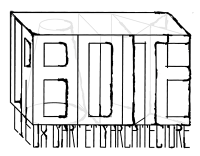- +216 71 772 000
- laboite@kilanigroupe.com
- Monday to Friday, 11am to 5pm.
Ali Tnani
It has never been to survive
September 2013 I December 2013
La Boîte I Un lieu d’art contemporain
Conceived both as an extension of my solo exhibition Contre-espaces at Galerie A. Gorgi, and as a fully-fledged part of my work with leftovers, the exhibition of the Others spaces series at La Boîte came at just the right time. At a time when my artistic practice was naturally converging towards new horizons, this exhibition evoked the beginnings of another approach to come. Now, these other spaces are no longer isolated and no cartography is possible for the moment. They are traversed without interruption by bodies and data.
Others spaces is a series of 8 photographs (silver, medium format) made during my first stay at the Cité des Arts in Paris in 2012 and published for the exhibition It has never been to survive at La Boîte, in 2013. My interest in empty and isolated spaces found a form of refuge in the residual spaces of the underground network. Invisible during the day and sometimes at night, they appear when they are illuminated.
Ali Tnani
“Ali Tnani (1982) multimedia artist, illustrator, installation artist, and photographer admits to having a soft spot for traces, archives, and transitional spaces. Things we readily discard, things that remain in limbo because we take no pleasure in looking at them. The world that attracts Tnani is also the one we live in, but, to tell the truth, it is the shadowy, hidden side. Our world? It is not made up solely of figures of light; it is also constructed against appearance, through neglect, through what is set aside, even through erasure. In his exhibition at La Boîte, “It Has Never Been To Survive,” Ali Tnani deliberately presents us with several photographs whose content is indiscernible. A provocation? Rather, an invitation to sharpen our senses, to hone our perception. Against a white background, placed on a horizon line, objects of indefinable abstract form present themselves to our questioning eyes. Fragments? Recycled material? Useful forms? Elements that cannot be defined and are dependent on the culture of the “formless” once dear to Georges Bataille? This type of uncertain visual offering, without pedigree, is nourished in Tnani’s work by what he himself calls the figure of “counter-space” or “other space”: a formulation connoting “difference .” This is further evidenced by his photographic series Other Spaces, whose content is both cryptic and explicit. Other Spaces #5: a square-format color photograph presents us with a low-angle view of an anonymous metal stairwell, the kind that clings to the back of buildings or in the heart of factories, not made to be seen. Other Spaces #8: this other photograph, of the same murky nature, reveals the banal view of a sidewalk curb. Almost nothing, then, nothing sublime, but nevertheless an essential element of reality. On what surface do we walk in our sprawling cities, if not on a sidewalk, which supports us and makes our movement easy? An artist fascinated by anti-spectacle, Ali Tnani’s “other spaces” feed into the allotopic theme, once dear to philosopher Michel Foucault. He acts as an archivist of these essential human places that we sideline because they do not generate symbolic added value. “My interest in empty and isolated spaces finds refuge in the residual spaces of the underground network,” explains Tnani. “Invisible during the day and sometimes at night, i An artist fascinated by anti-spectacle, Ali Tnani’s “other spaces” feed into the allotopic theme, once dear to philosopher Michel Foucault. He acts as an archivist of these essential human places that we sideline because they do not generate symbolic added value. “My interest in empty and isolated spaces finds refuge in the residual spaces of the underground network,” explains Tnani. “Invisible during the day and sometimes at night, they appear when illuminated (…).“ Figures of nothing? Certainly not, he continues. These spaces ”are constantly traversed by bodies and data.”
Paul Ardenne
